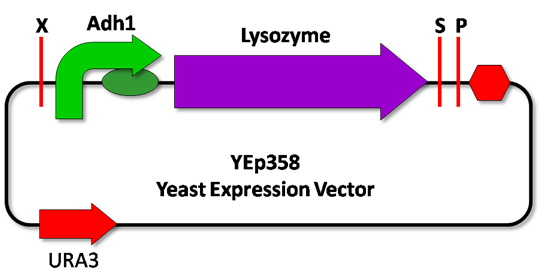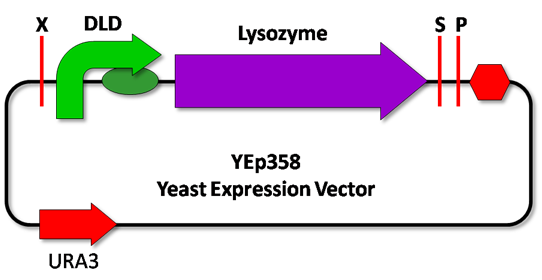The Yeastguard: Killing
The killing mechanism was designed based on the contaminants´ features. The lactobacilli are gram-positive bacteria and consequently have specific compounds in the cell wall. In addition, lysozyme is a protein that acts on the cell wall of gram-positive bacteria, catalyzing the hydrolysis of the peptidoglycan. Taking this into account, we decided to use the Lysozyme as a way to kill the contaminants and not cause injury to the yeasts.
The link between the recognition and killing mechanisms is the device that consists of one of the sensitive lactate promoters and the lysozyme (Figure 1).
Figure 1: Lysozyme from Gallus gallus regulated by JEN1 or DLD promoters from Kluyveromyces lactis
Killing protein: Lysozyme
The lysozyme is going to be amplified by PCR from the mRNA of Gallus gallus. The mRNA should be extracted from the organs that express the protein, so the test will be made with blood, spleen and oviduct. The expected amplicon have approximately 540bp.
Caracterization of the Biobrick
The lysozyme biobrick described above is going to be assembled according to the pGEM cloning strategy proposed by the team. And in order to caracterize the biobrick, its functionality must be seen in yeasts. Thus, the part is going to be transferred to an yeast expression vector (YEp358 ura+) and then be transformed into the Saccharomyces cerevisiae YF23 ura- strain.
The experiments will consists of lysozyme being regulated by a constitutive promoter ADH1(BBa_J63005), and by the two promoters designed for the recognition mechanism: JEN1 and DLD (Figure 2).
 
Figure 2: Lysozyme from Gallus gallus regulated by ADH1 and DLD promoters in YEP vector
After being plated on selective medium without uracil, the transformants will be selected and transferred to liquid medium also selective. From the initial OD of ~1.71 the growth of yeast will be monitored for 5 hours. The lysozyme expression will be verified by protein electrophoresis gel and by lactobacillus killing induction.
|